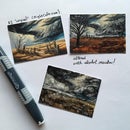Introduction: Sensory Table From Old Coffee Table
Over thirty years ago, when I taught preschool, one of the most functional items in the classroom was a piece of furniture that we called a "water table." This kind of thing is now called a "sensory table," and there are some high-end versions available, like this: https://www.amazon.com/exec/obidos/ASIN/B0013CBK1C/ezvid02-20
Of course, this is just the kind of project that can easily be constructed at home. I've seen a lot of variations on the internet, including this one on Instructables: https://www.instructables.com/id/Childrens-Sensory-Table/
But sometimes, it isn't even necessary to BUILD something. You can look a the things that you have, with an eye for creative mis-use.
Step 1: Obtain an Old Coffee Table.
This one became available when we downsized.
Step 2: Remove the Glass.
Fortunately, this particular coffee table was perfect for a second life as a sensory table:
Round. Safe smooth edges. Just the right height.
Step 3: Place a Large Piece of Fabric Over the Top.
The best fabric is a somewhat stretchy knit polyester. But tablecloths, sheets, or any large piece of fabric can be used.
I use different fabrics for different purposes, so the sensory table changes from day to day.
Step 4: Smoosh Down the Center.
This is a technical term. Smoosh down the center to form a pit.
Step 5: Tie.
Using a strong cord, such as paracord, tie around.
Carefully smoosh the fabric down again and tighten the cord.
Step 6: Add Sensory Items.
Rice is nice. Be sure to add objects for scooping and pouring.
Step 7: Add Children.
Have fun!
Step 8: Store the Sensory Items
Sometimes, I just unfasten the cord, gather the fabric, and re-tie the cord to form a fabric bag.
Step 9: Present the Next Collection of Little Things...
...such as this Halloween collection of orange and black confetti, sequin spiders, and little erasers.
Step 10: When Feeling Lazy.... LAYER....
Sometimes, when the layer of sensory items is fairly shallow and smooth (like the Halloween confetti), I just place a new layer over the top. Note that the green fabric from the previous picture is visible underneath this blue layer.
ALSO NOTE: I would not use marbles with young children. But my six-year-old grandson still enjoys the sensory table and he knows not to swallow marbles! When using marbles or small balls, add some tubes!
Step 11: Let the Children Choose!
I originally brought out the tubes to use with the marbles. The next time I brought out the rice, the children added the tubes themselves.
Step 12: Be on the Lookout for New Materials!
Flax seeds are smooth and shiny and very pleasant on little hands. Although they are expensive, they are really wonderful. If you add very small containers and spoons, a pound of unground flax seeds can be enjoyed for a very long time.
Quinoa is also lovely!
Cantaloupe seeds are also great. They're free if you have a cantaloupe-loving husband and you are willing to clean and dry them.
SAND is also a possibility. It is classic. But since my grandchildren have a sandbox at home, there is not need for sand at Grandma's.

Participated in the
Creative Misuse Contest













